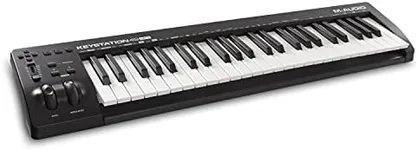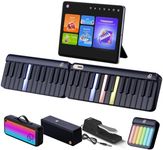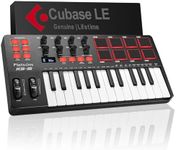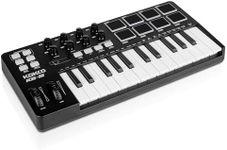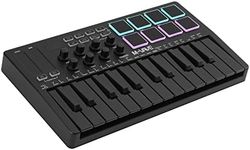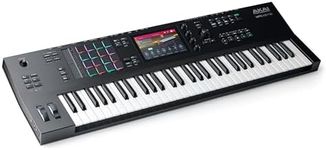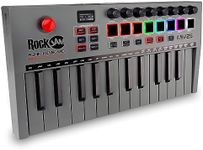Buying Guide for the Best Midi Keyboard Fl Studio
Choosing the right MIDI keyboard for FL Studio can significantly enhance your music production experience. A MIDI keyboard allows you to input notes and control various aspects of your digital audio workstation (DAW) with physical keys and controls, making the process more intuitive and expressive. When selecting a MIDI keyboard, consider your specific needs, such as the type of music you produce, your level of experience, and the space available in your studio setup. Here are some key specifications to consider when choosing a MIDI keyboard for FL Studio.Number of KeysThe number of keys on a MIDI keyboard determines the range of notes you can play at once. MIDI keyboards typically come with 25, 49, 61, or 88 keys. A 25-key keyboard is compact and portable, suitable for simple melodies and basslines. A 49 or 61-key keyboard offers a wider range, making it more versatile for playing chords and complex pieces. An 88-key keyboard provides the full range of a piano, ideal for classical pianists or those who want the most expressive range. Choose based on your playing style and the space you have available.
Key ActionKey action refers to how the keys feel when you press them. There are three main types: synth-action, semi-weighted, and fully-weighted (hammer action). Synth-action keys are light and springy, suitable for fast playing and electronic music. Semi-weighted keys offer a bit more resistance, providing a balance between synth-action and fully-weighted keys. Fully-weighted keys mimic the feel of an acoustic piano, offering the most realistic playing experience. Your choice should depend on your preference and the type of music you produce.
Pads and ControlsMany MIDI keyboards come with additional pads and controls, such as drum pads, knobs, faders, and buttons. These features allow you to trigger samples, adjust parameters, and control various aspects of your DAW without using a mouse. Drum pads are great for creating beats, while knobs and faders can be assigned to control volume, effects, and other settings. If you prefer hands-on control and want to streamline your workflow, look for a keyboard with these additional features.
ConnectivityConnectivity options determine how you can connect your MIDI keyboard to your computer and other devices. Most MIDI keyboards connect via USB, which is straightforward and provides power to the keyboard. Some models also offer traditional 5-pin MIDI ports, allowing you to connect to other MIDI hardware. Additionally, some keyboards have sustain pedal inputs and expression pedal inputs for added control. Ensure the keyboard you choose has the necessary connectivity options for your setup.
Compatibility with FL StudioWhile most MIDI keyboards are compatible with FL Studio, some models offer better integration with the software. Look for keyboards that come with pre-mapped controls for FL Studio, making it easier to use right out of the box. Some keyboards also come with software bundles that include FL Studio or other music production software, providing added value. Check the manufacturer's specifications to ensure seamless compatibility with FL Studio.
Build Quality and PortabilityThe build quality of a MIDI keyboard affects its durability and longevity. Keyboards made with high-quality materials and solid construction are more likely to withstand regular use. Portability is another factor to consider, especially if you plan to take your keyboard to gigs or different studios. Lightweight and compact models are easier to transport, while larger, sturdier models may be better suited for a permanent studio setup. Choose a keyboard that matches your lifestyle and usage patterns.
![Novation Launchkey 88 [MK3] - premi](https://images-proxy.bestreviews.guide/2QI-9X2x142pOvyWnircYf1EhbM=/0x150/https://m.media-amazon.com/images/I/31ITqTl+AVL._AC_CX679_.jpg)
![Novation Launchkey 49 [MK4] – 49 ke](https://images-proxy.bestreviews.guide/kwBi3KOQ8VhcPZsxwIqXv0GShAw=/0x150/https://m.media-amazon.com/images/I/31+piTXoAhL._AC_CX679_.jpg)
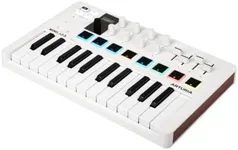

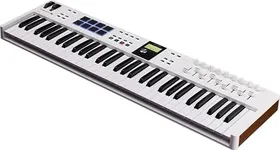
![Novation Launchkey Mini 37 [MK4] —](https://images-proxy.bestreviews.guide/HsAw05pM9DR9pDasv7ynfmPAR94=/0x150/https://m.media-amazon.com/images/I/31dZ9YOPz7L._AC_CX679_.jpg)


